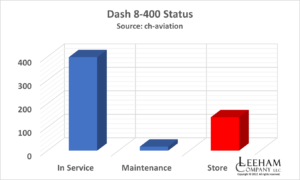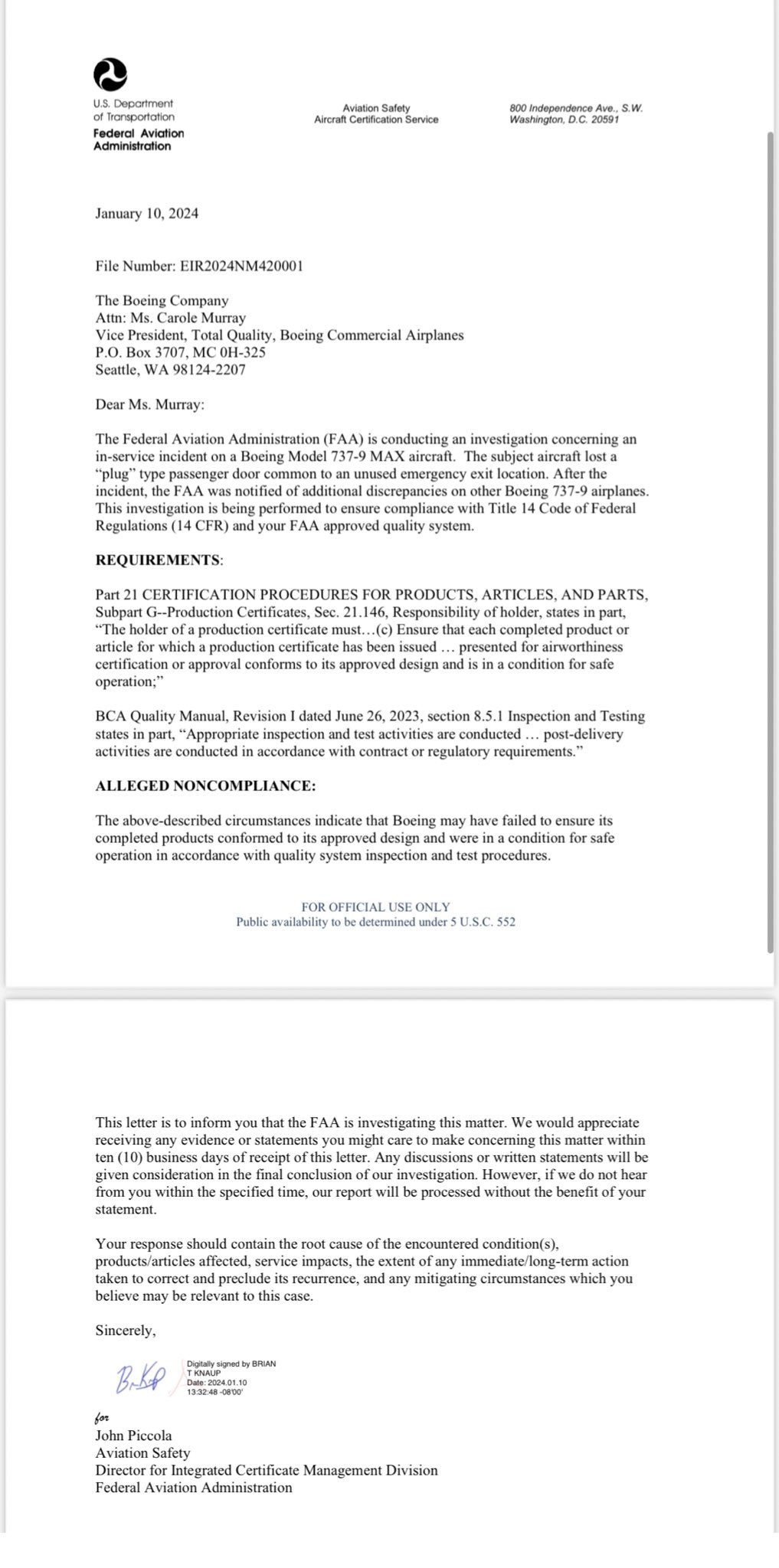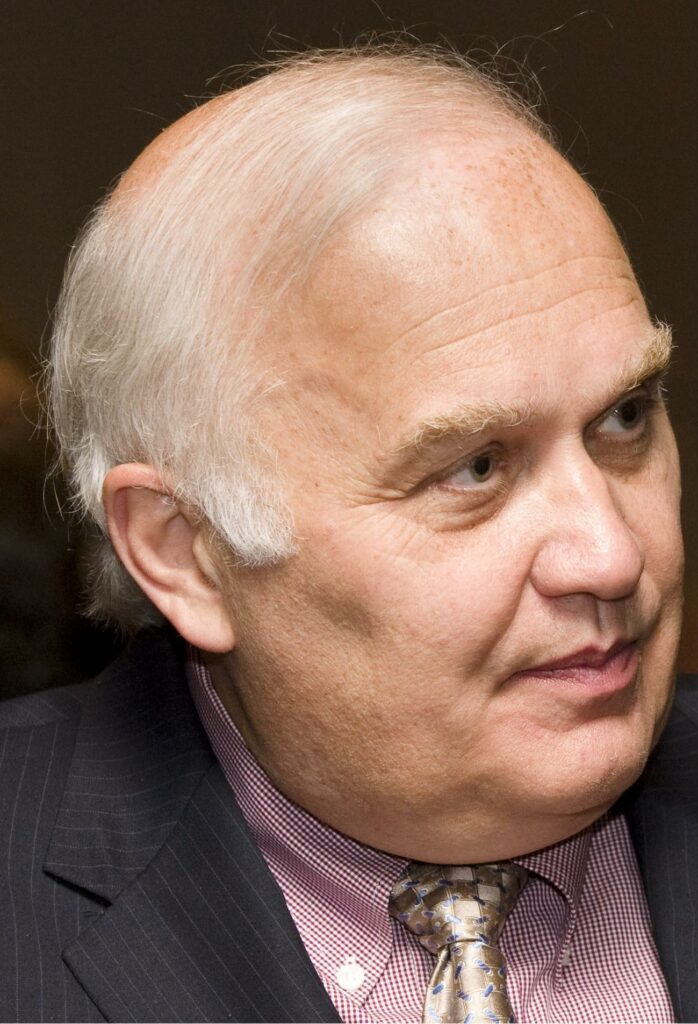Leeham News and Analysis
There's more to real news than a news release.
Alaska 1282 isn’t a “737 MAX” story; it’s about quality assurance at Boeing or Spirit
Update: The Federal Aviation Administration today notified Boeing it is under investigation for potentially failing to ensure the door plug was properly installed.
By Scott Hamilton
Jan. 11, 2024, © Leeham News: Alaska Airlines Flight 1282’s (AS 1282) decompression last Friday on a Boeing 737-9 MAX understandably brought new focus and doubts about the MAX program.
The MAX was grounded by the Federal Aviation Administration for 21 months after the March 2019 crash of an Ethiopian Airlines 737-8 MAX. This followed an October 2018 crash of a Lion Air MAX 8 under similar flight conditions. The two accidents were traced to the root cause of a mis-designed Maneuvering Characteristics Augmentation System, or MCAS.

Note: This data is based on October 2023 information. Full year 2023 data is not available at this writing.
When a door plug for an inactive emergency exit blew out of AS 1282 at 16,000 ft minutes after departure from Portland (OR), it meant trouble for Boeing and confidence in the MAX. Fortunately, no fatalities and only a few minor injuries resulted from the decompression. The flight returned to Portland and landed safely.
Alaska grounded its fleet of 65 MAX 9s within hours. United Airlines followed the next day. It has more MAX 9s—79—than any other airline. Shortly after United’s action, the FAA made it mandatory: the MAX 9s would remain grounded until inspections and fixes, if required, could be completed. A few other international airlines followed suit.
But as information emerged through Tuesday of this week, it became clear that this story is not a “MAX” story. It’s a story about quality assurance at Boeing or Spirit AeroSystems, the maker of the 737 fuselages and the plug door.
HOTR: United likely can cancel A350 order with little penalty
By the Leeham News Team
Dec. 5, 2022, © Leeham News: United Airlines appears on the cusp of ordering as many as 100 Boeing 787s, multiple news outlets report. Airbus hopes to sell more A350s to United to supplement the 45 already on order.
 But these 45 A350-900s are an order that has been viewed as iffy since United merged with Continental Airlines. Although ostensibly United was the surviving carrier, in reality, Continental was the survivor. The latter’s management displaced United’s old management. The livery retained was Continental’s.
But these 45 A350-900s are an order that has been viewed as iffy since United merged with Continental Airlines. Although ostensibly United was the surviving carrier, in reality, Continental was the survivor. The latter’s management displaced United’s old management. The livery retained was Continental’s.
The A350 order was placed by the old United management. The new executives added to the United order, but Continental had been an exclusive buyer of Boeing aircraft and executives were predisposed toward Boeing. UAL now has 120 Airbus A321XLRs on order. But this came after Boeing couldn’t decide whether to launch the New Midmarket Airplane after years of dithering. With a large fleet of Boeing 757s aging and in need of eventual replacement, United could no longer wait for Boeing to make a decision.
United already has a large fleet of 787s. Adding the A350s will provide an extra range that the 787s don’t have. But how many routes need the extra range to justify another fleet type?
LNA believes that United can cancel the orders for 45 A350s at little cost. The deposits may easily be applied to orders for more A321s, but cancellation penalties are believed to be de minimis. Based on 2018 list prices—the last ones published by Airbus—United could get about 110 more A321s in exchange for the A350s. (The number is probably a little less since the XLRs are more expensive than the A321neo “standard;” the list price makes no distinction between the sub-types.)
LNA expects United to cancel the A350s sooner than later and add to the A321 order.
Pontifications: China still needs Boeing as much as Boeing needs China
July 11, 2022, © Leeham News: The July 1 announcement by Airbus that it won orders for 292 airplanes from China, for the Big Three carriers, was treated as a shocker by some.
Boeing, which has been frozen out of the Chinese market since 2017, blamed geopolitical issues for its dry spell. To be blunter, blame it on former President Donald Trump, who began a trade war with China that inexplicably continues well into the first term of the Biden Administration.
Trump’s shoot-from-the-lip foreign policy routinely failed to consider geopolitical issues. Joe Biden is more thoughtful, but 18 months into his presidency has done little to repair relations with China. To be sure, there must be a balance when dealing with China and trade.
The country routinely engages in cyber-based industrial espionage, and this must be stopped. Honoring intellectual property rights is mere rhetoric by Beijing. But about a third of orders for Airbus and Boeing historically come from China. Boeing has about 140 737 MAXes in long-term storage destined for China. Despite global air traffic recovery, China’s zero-tolerance policy toward COVID continues to suppress domestic demand, another factor in Boeing’s storage problem.
But geopolitics is a real issue. Here’s what Boeing said following the Airbus order:
Pontifications: Horizon’s plan to focus on single fleet type appears a blow to TPNG hopes
March 29, 2022, © Leeham News: Alaska Air Group announced last week that its subsidiary, Horizon Air, will retire 32 De Havilland Canada (DHC) Dash-8-400s by the end of 2023. The regional airline will go to a single fleet type, the Embraer E175-E1. AAG owns some of the 175s. Regional partner SkyWest owns and operates others.
The plan adds to the struggles of DHC to return to service -400s stored at the start of the COVID pandemic. At the end of 2021, there were more than 150 stored. As of last week, this number was down to 142, according to the ch-aviation data base. Another 17 were in maintenance. There were 398 in service. The number stored represents 25% of the -400 fleet.
Consolidating to a single fleet type doesn’t bode well for Embraer’s efforts to win Alaska/Horizon as a launch customer for its new TPNG. This advanced turboprop, proposed in 70- and 90-seat versions, has engines mounted on pods at the rear in the latest concept shown to the industry. A new engine will replace the aging but reliable Pratt & Whitney PW-series used on the Dash 8 and ATR-42/72. P&W, GE and Rolls-Royce are developing a new generation engine.
Embraer wants to launch the program this year with a proposed entry into service of 2027.
“Downfall” and “Boeing’s Fatal Flaw”
Feb. 17, 2022, (c) Leeham News: Tomorrow the documentary movie Downfall will be available on Netflix and, probably, Youtube. Unveiled during the Sundance film festival, Downfall is about the Boeing 737 MAX crisis.
The producers’ staff of Downfall contacted me during their research. I told them, among other things, that you had to know what else was going on at the time at Boeing when MAX was launched in July 2011 in order to understand the full context of Boeing during that period. The underlying thesis–that re-engining the 737 and decisions made–wasn’t only about profit, shareholder value, or greed, as many suggested. In fact, Boeing reported a $4bn in 2011 despite the pressures.
- The 787 hadn’t been delivered. It was three years late. Boeing was billions and billions over budget.
- The 747-8 was late and billions over budget.
- The tanker contract had been awarded the previous February with a bid 10% less than Airbus—and as we now know, it, too was late and billions over budget.
- Boeing’s engineering resources were stretched to the point where engineers were diverted to the 787 from other programs and outsourcing engineering work to India and Russia was done. The work from India on the 747-8 was poor and had to be re-done by SPEEA, further straining resources.
HOTR: Boeing works on HGW 787-10—and the 787-9
 Jan. 5, 2022, © Leeham News: In his first interview since becoming CEO of Boeing Commercial Airplanes, Stan Deal told The Seattle Times that development of a High Gross Weight (HGW) version of the 787-10 is underway.
Jan. 5, 2022, © Leeham News: In his first interview since becoming CEO of Boeing Commercial Airplanes, Stan Deal told The Seattle Times that development of a High Gross Weight (HGW) version of the 787-10 is underway.
“[Deal] also revealed that Boeing is currently designing a new ‘high gross weight’ version of the largest Dreamliner, the 787-10, bumping up its payload and range to make it more competitive against the Airbus A350-900.”
But LNA learned exclusively that Boeing also is developing an HGW version of the 787-9.
Airbus critics reach low blow in forthcoming KC-Y competition
By Scott Hamilton
Analysis
Jan. 4, 2022, © Leeham News: The US Air Force KC-Y tanker competition hasn’t even started but Boeing partisans already have the knives out.
For at least the fourth time, an OpEd appeared attacking Airbus for illegal subsidies. For good measure, the writer also pointed to Airbus’ misdeeds in its bribery scandal and other misadventures. All this in what increasingly appears to be the opening shots in a campaign to politicize the coming KC-Y Bridge Tanker procurement.
Once more, Boeing will be pitted against Airbus and the KC-46A against the A330 MRTT. This time, Airbus partnered with Lockheed Martin to take on Boeing. The latest column hit the Internet on Christmas Eve. This time, a Congressional staffer called on Airbus to be “Grounded” in the KC-Y competition.
This column was one of the most irresponsible commentaries seen so far. And this is saying something.
Pontifications: Assessing the advantages Boeing, Lockheed Martin-Airbus have in KC-Y tanker competition
Fourth in a Series
Jan. 3, 2022, © Leeham News: As the US Air Forces gears up to solicit bids for its KC-Y aerial refueling “bridge tanker” competition, Boeing is now the incumbent tanker supplier.
Having won the KC-X competition against Airbus, Boeing is supplying a total of 179 tankers based on the 767-200ER. The KC-46A, however, has been plagued with problems, delays, and cost overruns.
As the incumbent, Boeing would seem to have an advantage in the KC-Y competition. But on the other hand, the problems that Boeing has had in technical compliance categories, failures, and delivery delays, and foreign object debris issues, could work against it.
Sean O’Keefe was the president of EADS North America, Airbus’ parent when Boeing won the KC-X contract. He also worked for the government as the NASA administrator and on The Hill. He was friends with Bob Gates, the Secretary of Defense during parts of the Bush 43 and Obama administrations. This gives him a special insight from government and industry perspectives to weigh the advantages and disadvantages Boeing faces in the anticipated KC-Y contest that will likely pit the incumbent against the Lockheed Martin-Airbus team that will once again offer the A330-200-based tanker called the LMXT.
Air Wars is now available via Barnes and Noble
 Dec. 29, 2021: Air Wars, The Global Combat Between Airbus and Boeing, is now available in paperback via Barnes and Noble. It is also available via Amazon in paperback and eBook.
Dec. 29, 2021: Air Wars, The Global Combat Between Airbus and Boeing, is now available in paperback via Barnes and Noble. It is also available via Amazon in paperback and eBook.
Air Wars is by LNA’s Scott Hamilton. It covers 35 years of the global sales and product strategy between Airbus and Boeing. John Leahy, who retired in January 2018, led Airbus’ sales teams in the US and globally for most of his 33 years at Airbus. The book covers his successes and failures, campaigns against Boeing and gets both sides of these campaigns and product strategies from key people like Leahy, Tom Enders, Kiran Rao, Tom Williams and Leahy’s successor, Christian Scherer at Airbus; and Ray Conner, Jim Albaugh, Scott Carson, Toby Bright and John Feren from Boeing. Industry players like Steven Udvar-Hazy and John Plueger are also interviewed.





